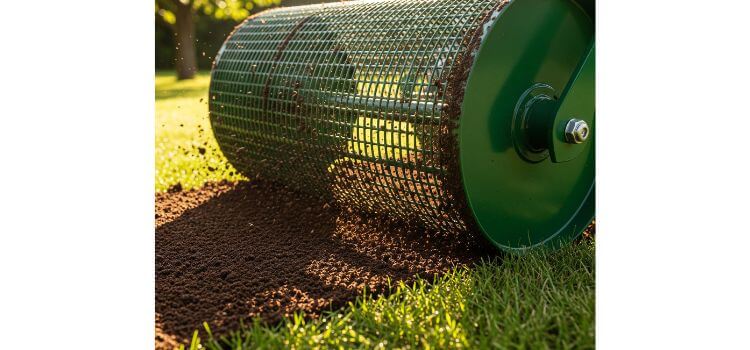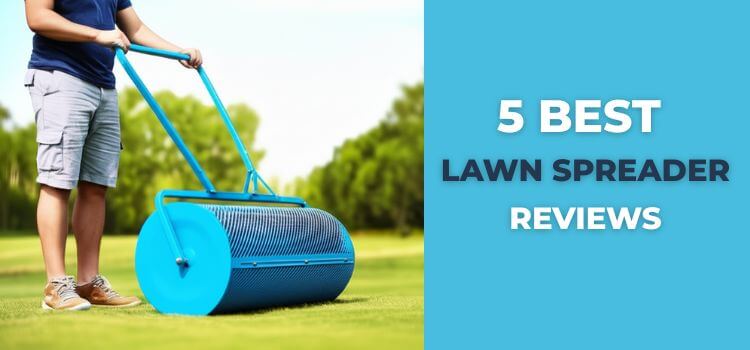As an Amazon Associate, I earn from qualifying purchases.
Do you know why some lawns look like a green carpet and others look patchy?
I learned the answer the hard way. My grass used to grow in uneven colors. Some spots looked burnt, others pale. The reason was simple — my seeds and fertilizer were not spread evenly.
That is when I discovered that using a lawn spreader is the secret to an even, healthy lawn. This tool spreads seeds, fertilizer, or even salt in winter in a consistent way. Without it, you risk wasting money and damaging your grass.
When you choose the best lawn spreader, you make lawn care easier, faster, and more accurate. Even heavy rains or dry spells will not ruin a well-spread lawn as easily.
So, let’s explore everything you need to know from types and features to real-life tips so that you can make the right choice.
How to Choose the Right Lawn Spreader for Your Lawn
Before buying, ask yourself these essential questions:
- Does my yard have tight corners or wide open spaces?
- How big is my lawn?
- Do I want fast coverage or precise control?
- Will I spread seed, fertilizer, or both?
There are three main types of lawn spreaders to know:
- Broadcast Spreaders – These throw seeds or fertilizer in a wide pattern. Suitable for large lawns. I used one last year for my 1,500 sq. ft. front yard. The coverage was fast and even. But if you are near a flower bed, you need to be careful not to overshoot.
- Drop Spreaders – These drop seeds straight down between the wheels. Very precise. Great for small lawns or tight spaces. My uncle in Dhaka uses one for his tiny rooftop garden because it avoids waste.
- Handheld Spreaders – These are small and easy to carry. Perfect for small areas or spot treatments. I keep one to fix bare patches after kids play football on the grass.
Here is a quick table for comparison:
| Type | Best For | Pros | Cons |
|---|---|---|---|
| Broadcast | Large lawns | Fast coverage, easy to use | Less precise near edges |
| Drop | Small/medium lawns | Very accurate | Slower than broadcast |
| Handheld | Small areas, spot fixing | Cheap, portable | Not for big lawns |
Note: Always match the spreader type to your lawn size and needs.
Note: Read the instructions before use to avoid waste and uneven spreading.

Top 5 Best Lawn Spreaders Reviewed 2025
Let’s start with a quick look at the top 5 lawn spreaders for 2025. This simple table shows their main features so you can easily see which one might fit your lawn best.
Product Name | Product Material | Handle Type | View Product |
LANDZIE Lawn & Garden Spreader | Not specified (product form: granules, powder) | Not specified | |
VEVOR Compost Spreader | Alloy Steel | Height Adjustable Handle | |
KENDIYAS Compost Spreader | Powder Coated Steel | Ergonomic T-Shaped Handle | |
Raxjult Compost Spreader | Premium Steel Mesh | Adjustable T-Handle with Lock Buckle | |
Hiboom 36 Inch Compost Spreader | Heat Treated Iron | Adjustable Ergonomic T-Shaped Handle |
1. LANDZIE Lawn & Garden Spreader
The LANDZIE Lawn & Garden Spreader features a 36-inch metal mesh basket designed for even spreading of compost, peat moss, topsoil, mulch, and manure. Its sturdy, powder-coated frame resists rust and corrosion while being lightweight for easy pushing or towing behind a tractor or lawn mower. The mesh basket breaks up clumps and separates waste, ensuring smooth distribution. With a hinged door for easy filling and secure latches, this spreader makes lawn care faster and less tiring, perfect for maintaining a healthy, green lawn with less effort.
Why You’ll Love This
- Large 36-inch mesh basket spreads materials evenly and consistently
- Can be pushed by hand or towed for greater convenience
- Powder-coated frame protects against rust and damage
- Hinged door makes filling mess-free and straightforward
- Breaks up clumps for smoother spreading and less waste
Pros
- Durable, lightweight construction
- Versatile use with different lawn materials
- Easy to assemble and operate
- Excellent customer service from the brand
Cons
- Best suited for medium to large lawns; smaller areas might find it bulky
- May require removing handle grips when towing to avoid bending
2. VEVOR Compost Spreader
The VEVOR Compost Spreader features a durable 24-inch powder-coated steel mesh basket designed for spreading compost, manure, peat moss, topsoil, and more. It includes adjustable handle heights for comfortable use by different people and strong side latches that keep the basket secure during use. Lightweight yet sturdy, this spreader works well on flat or uneven surfaces, making lawn topdressing faster and less tiring. Its design helps distribute materials evenly, improving lawn health while saving you time and effort.
Why You’ll Love This
- Adjustable handle for a comfortable fit
- Strong side latches keep the basket securely closed
- Powder-coated steel resists rust and damage
- Lightweight but durable for easy pushing
- Works smoothly on slopes and uneven ground
Pros
- Easy to assemble and operate
- Versatile for many lawn materials
- Lightweight design for easy maneuvering
- Durable powder-coated finish
Cons
- Not ideal for spreading materials with large debris
- Handle height adjustment is limited to two positions
3. KENDIYAS Compost Spreader
The KENDIYAS compost spreader features a durable powder-coated steel basket designed to resist rust and damage, with upgraded doors and a reinforced frame to prevent distortion. Its ergonomic T-shaped handle enhances maneuverability, making it easier to push or pull over various surfaces. This spreader breaks up clumpy materials evenly as it rolls, spreading peat moss, compost, mulch, and fertilizer efficiently across lawns and gardens. The spring-loaded door latches secure materials inside for mess-free use. Lightweight yet sturdy, it is a reliable tool for top dressing and lawn care.
Why You’ll Love This
- Ergonomic T-shaped handle for easy pushing and pulling
- Durable powder-coated steel resists rust and damage
- Spring-loaded door latches keep materials securely inside
- Breaks up clumps for even spreading of compost and mulch
- Lightweight and smooth rolling on different surfaces
Pros
- Easy to assemble without tools
- Efficiently spreads a variety of materials.
- Sturdy construction with rust-resistant finish
- Upgraded doors for quick loading and unloading
Cons
- May require frequent refilling for large jobs
- Some users report minor issues with door latches
4. Raxjult Compost Spreader
The Raxjult compost spreader features a sturdy metal mesh basket with thickened diamond-shaped holes to ensure durability and efficient spreading of materials like peat moss, fertilizer, sand, and manure. Its adjustable T-shaped handle provides a comfortable grip and reduces fatigue during use. The one-click locking side buckles keep the basket securely closed while rolling. This spreader offers an easy-to-assemble design and uniform spreading performance, making lawn and garden care more straightforward and more efficient. Ideal for small to medium-sized lawn projects, it saves time and effort compared to manual spreading.
Why You’ll Love This
- Adjustable ergonomic T-handle for comfort and control
- Thickened steel mesh basket for long-lasting durability
- One-click lock buckles secure the basket doors firmly
- Versatile for spreading compost, seeds, fertilizer, and mulch
- Efficient and even material distribution saves time
Pros
- Comfortable handle reduces user fatigue
- Solid metal mesh withstands regular use
- Easy assembly with pre-drilled holes
- Good value for occasional lawn care tasks
Cons
- Instructions are small and hard to read
- Some users report latch durability issues.
5. Hiboom 36 Inch Compost Spreader
The Hiboom 36-inch Compost Spreader offers a large 2.7 cubic feet capacity with a durable metal mesh basket designed for spreading peat moss, manure, topsoil, compost, and mulch efficiently across lawns and gardens. Its adjustable T-shaped ergonomic handle (42–47 inches) enhances comfort and control for users of different heights, making pushing and pulling easier on various terrains. The spreader features side locks that keep the basket securely closed during operation, preventing spills and ensuring smooth rolling.
Why You’ll Love It
- Large capacity saves time on bigger jobs
- Adjustable, ergonomic T-handle reduces fatigue
- Durable powder-coated metal mesh resists rust and corrosion
- Smooth, even spreading for compost, manure, topsoil, and mulch
- Secure side-lock design keeps the basket closed
Pros
- Great for medium to large lawn and garden areas
- Comfortable handle for extended use
- Sturdy construction with rust-resistant finish
- Lightweight and easy to maneuver
Cons
- The instruction manual is very unclear and has small print
- Assembly is challenging and time-consuming for many users
You may also read:
5 Best Indoor Plant Grow Lights
5 Best Cordless Lawn Mower
5 Best Weed Puller Tools
5 Best Pots for Plants
Key Features to Look for in a Lawn Spreader
Choosing a spreader is more than size and type. Look for these key features:
- Adjustable Flow Rate: Control how much seed or fertilizer you spread. Different products need different amounts.
- Durable Wheels: Bigger wheels roll better over uneven ground and grass.
- Comfortable Handle: Padded or adjustable handles reduce hand and back strain.
- Easy to Clean: Spreading fertilizer can cause rust. Make sure you can easily clean your spreader after use.
- Capacity: Bigger hoppers mean fewer refills. However, being too big can make it heavy and hard to handle.
According to a 2024 garden tool survey, 68% of lawn owners chose capacity as a top factor. But remember, bigger isn’t always better. Match the spreader to your yard size and strength.
Tips for Using Your Lawn Spreader Effectively
Even the best spreader can give poor results if misused. I learned this the hard way when I forgot to close the spreader gate while turning, doubling fertilizer in one spot. The grass burned badly.
Follow these simple steps for success:
- Read Instructions: Each spreader and fertilizer has different settings.
- Fill on Hard Surface: If you spill, it’s easier to clean up.
- Walk at a Steady Pace: Too fast and coverage is thin; too slow and it’s too heavy.
- Overlap Slightly: This prevents streaks or gaps.
- Clean After Use: Dry the spreader before storing to avoid rust.
Imagine spreading fertilizer like painting a wall. You don’t want gaps or heavy spots. Keep a steady path for even results.
Frequently Asked Questions About Best Lawn Spreaders
Q1: How often should I use a lawn spreader?
Most lawns need spreading 3-4 times a year for seeds or fertilizer, depending on grass type and climate.
Q2: Can I use the same spreader for salt in winter?
Yes, but clean it thoroughly after use to prevent rust and damage.
Q3: What is the best setting for my spreader?
Follow the instructions on your seed or fertilizer bag. Settings can vary by brand and product.
Q4: Can I use a spreader on wet grass?
It’s not recommended. Wet grass can cause clumping and uneven spreading.
Q5: How do I maintain my lawn spreader?
Always clean and dry it after use. Check wheels and moving parts for damage regularly. Store in a dry place.
Final Thoughts
The best lawn spreader depends on your yard size, how precise you want to be, and your comfort.
- For large yards where speed matters, a broadcast spreader is best.
- For small or detailed areas, a drop spreader offers better control.
- For quick patch fixes, a handheld spreader works well.
Remember, an uneven lawn looks like an uneven haircut — everyone notices. Using a good spreader will help you get a neat, healthy, and beautiful lawn all year round.

